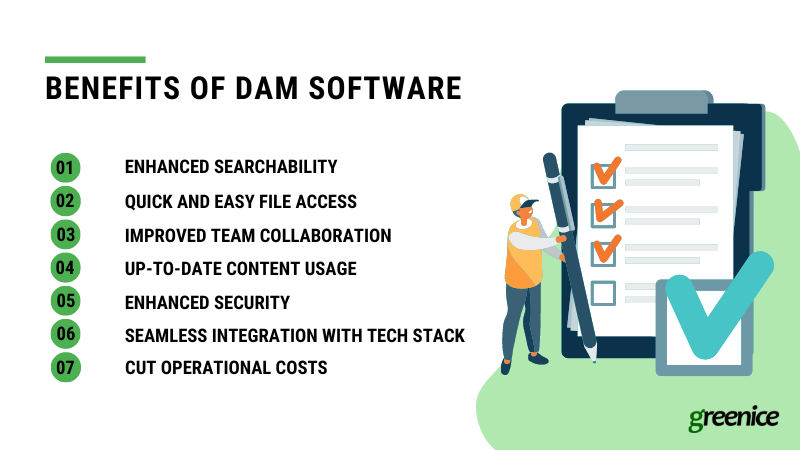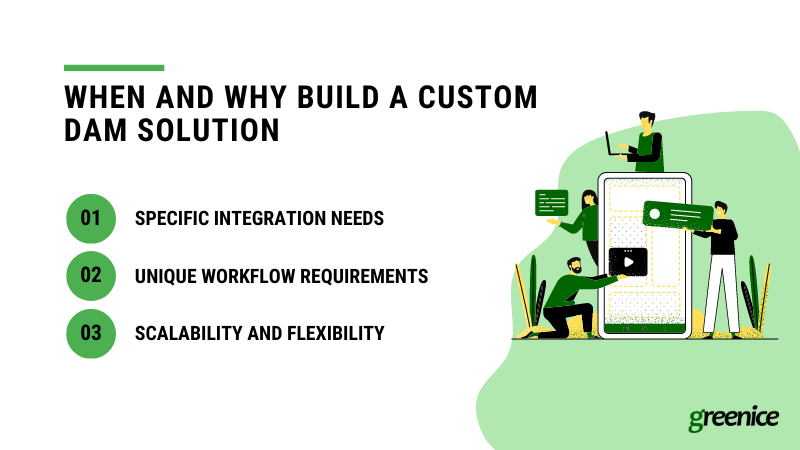Terabytes of valuable content are useless if you cannot find what you are looking for.
In today's digital age, managing vast quantities of digital assets effectively is crucial for businesses across various industries. A Digital Asset Management (DAM) system is not just a tool but a transformative solution that organizes, stores, and retrieves media, improving operational efficiency.
The Digital Assets market is growing rapidly, with an expected annual growth rate (CAGR) of 8.77% from 2024 to 2028, reaching a market volume of $112,100 million. By 2028, the number of users is anticipated to hit nearly 992.50 million, underscoring the expanding need and economic impact of DAM systems.
This article will help you understand the DAM system, how to choose the right one for your business, and what specific industries benefit most from these systems. So let’s figure out how to create this DAM system (pun is intended)!
What is a Digital Asset Management system?
A Digital Asset Management system serves as a centralized repository essential for managing a diverse array of digital assets such as photos, videos, graphics, and documents. Within these systems, assets can be tagged with metadata to simplify organization, search, and retrieval. For example, marketing teams can label images with campaign names or product identifiers. The system also archives older assets to keep them accessible without cluttering the active workspace.
Types of digital assets
Digital assets include but are not limited to:
- Images (photographs, graphics, digital artworks, logos)
- Video files (animations, promos, videos, movies)
- Audio files (music, audiobooks, voice tracks)
- Documents (PDFs, Word documents, presentations)
- Blockchain (NFTs, Cryptocurrencies, Central Bank digital currencies, security tokens)
Why Digital Asset Management is important
DAM systems streamline the process of accessing, sharing, and managing digital files within an organization.
The benefits include:

- Enhanced searchability: DAM systems organize digital assets in a centralized location, greatly simplifying the search process. Equipped with advanced search engines, often enhanced by AI, these systems allow for precise querying based on metadata and tags associated with each file. This structured approach ensures that users can quickly and easily locate the specific assets they need.
- Quick and easy file access: Being predominantly cloud-based, DAM systems allow consistent access to digital assets from any internet-connected device. All digital content is stored in one location, speeding up the retrieval process and enabling both internal and external stakeholders to focus on more critical tasks. Tailor access rights and permissions to ensure that the right people have the right level of access to files.
- Improved team collaboration: Team members can access, edit, and manage documents efficiently. This streamlined access helps reduce redundancy and ensures that everyone is working with the most current version of each document, boosting productivity and collaboration across the organization.
- Up-to-date content usage: DAM systems reduce the risk of using outdated files, as important assets are readily updated and accessible, ensuring all stakeholders use the most current content.
- Enhanced security: Centralized, secure storage mitigates the risk of losing important and confidential files, which can often occur with decentralized storage solutions like external hard drives or personal devices. Additionally, it enables secure sharing of files directly from the platform, with options to set expiration dates and track the sharing history, ensuring controlled use of shared assets.
- Seamless integration with tech stack: DAM systems integrate smoothly with a wide range of technological tools, from CMS (Content Management System) and PIM (Product Information Management) systems to design and social media tools, streamlining the flow of digital assets across the content lifecycle.
- Cut operational costs: Faster creation, retrieval, storage, and distribution of digital content leads to significant time savings, directly enhancing ROI across marketing and branding efforts.
How to choose the best DAM for your business?
Choosing the right DAM system involves understanding specific criteria and requirements tailored to your business needs.
Criteria and requirements:

- Storage limits and prices: Evaluate the storage capacity and cost implications to ensure they align with your business scale.
- Search options: Look for advanced search functionalities that cater to your specific use cases, including metadata, tags, and visual search capabilities.
- Organization options: Check for intuitive ways to categorize, tag, and archive content.
- User management: Consider the ease of managing user permissions and roles within the DAM system.
- Integrations: Ensure compatibility with existing tools and software in your business environment.
- Specific features: Identify any unique features needed such as version control, offline access, or AI-based organization tools.
Digital Asset Management use cases
There are numerous types of digital assets and just as many scenarios where Digital Asset Management systems are necessary. Here are just some of them:

- Brand management: To maintain a unified brand image across all platforms, a DAM system centralizes all brand-related assets, ensuring consistent use of logos, colors, and messaging. It controls access to these assets to prevent unauthorized use and tracks asset usage to ensure compliance with brand guidelines, thereby safeguarding brand integrity and recognition.
- Creative workflow: A DAM system streamlines creative processes by automating routine tasks and facilitating real-time collaboration. It supports direct feedback on assets, organizes content with metadata, and maintains an archive for easy retrieval, speeding up project approvals and enhancing team efficiency across multiple locations.
- Regulatory compliance and auditing: Industries like healthcare and finance often face stringent regulatory requirements concerning how digital content is stored, accessed, and secured. A DAM system can automate compliance processes by providing features such as audit trails, access logs, and expiration settings for sensitive documents, ensuring that companies meet legal standards.
- Asset preservation and archiving: Cultural institutions like museums and libraries use DAM systems to preserve digital reproductions of artifacts, documents, and artwork. DAM systems provide high-resolution storage options and metadata tagging to ensure historical data is organized and accessible for educational purposes and digital exhibitions.
- Content syndication: Media companies can use DAM systems to distribute content across multiple platforms and formats. By centralizing digital assets, a DAM facilitates the syndication process, allowing for quicker updates and consistency across channels, which is essential for news outlets and content distributors.
- Product information management: For businesses that manage extensive product lines, like retailers and manufacturers, DAM systems integrate with PIM systems to centralize all marketing materials and product data. This integration ensures that the latest product information is easily accessible and consistently used across all marketing and sales channels.
- Digital rights management: Companies that deal with licensed content, such as publishing and music firms, can benefit from a DAM system's ability to manage copyright information and licensing rights. DAM systems can track usage rights, prevent unauthorized access, and alert managers when licenses need renewal.
- Localization and global marketing: Global businesses use DAM systems to store and manage versions of marketing materials that are localized for different regions. This includes translations and culturally adapted content, ensuring all materials are relevant and compliant with local market regulations.
- Event management: Event organizers use DAM systems to manage multimedia content like videos, photos, and presentations from various events. This centralization allows for easy access when planning future events and for marketing purposes, ensuring materials are readily available and organized.
- Educational resources and training: Educational institutions and corporate training departments use DAM systems to manage instructional materials, including videos, tutorials, and documentation. This ensures that students and employees have access to consistent training materials regardless of their location.
- Cryptocurrencies and non-fungible tokens (NFTs): A blockchain-based DAM system offers a robust solution by creating fixed records for each asset on a decentralized ledger. This ensures transparent ownership tracking, fraud prevention, and secure asset transfers. Smart contracts automate transactions and rights management, enhancing efficiency and trust among buyers, sellers, and creators in the digital economy.
Though DAMs have multiple applications, they are especially beneficial for certain industries, e.g.:

- Media and entertainment rely on DAM to manage vast multimedia libraries, ensuring quick retrieval and regular updates crucial for responding to market demands.
- Advertising and marketing uses DAM to store and organize campaign materials, maintaining brand consistency across all media channels by using a central repository of approved assets.
- eCommerce employs DAM to manage high-quality images and videos that influence purchasing decisions, enhancing content delivery with features like product-specific linking and bulk exports.
- Healthcare uses DAM to securely manage sensitive documents such as patient records and medical imaging, ensuring compliance with health regulations like HIPAA and improving retrieval efficiency.
- Legal applies DAM for archiving extensive case files and documents, facilitating easy access and compliance with legal standards for document retention and privacy.
Features of DAM systems
Here's a brief overview of both basic and advanced features if you want to design asset management software:
Basic features:
- Centralized storage: All digital assets are stored in one secure location.
- Search and metadata: Powerful search capabilities enabled by comprehensive metadata tagging. Additionally, DAM platforms must use standards like IPTC for metadata to ensure optimal structure, description, and access to data.
- Access control: Configurable permissions to control who can view, edit, or distribute assets.
Advanced features:
- Advanced filtering: Allows users to refine searches based on multiple attributes like date, type, creator, and more.
- AI-powered tools: AI technologies for image recognition and automatic tagging, enhancing searchability and asset organization.
- Version control: Tracks changes to assets and allows users to revert to previous versions if needed.
These features collectively help organizations manage their digital assets more efficiently, ensuring that they are secure, easy to access, and effectively integrated into their broader operational workflows.
However, you are not limited to these features and can tailor your platform functionality based on your needs.
Integrations:
It is possible to further improve productivity and access and distribution of digital assets across an organization with the help of integrations. These integrations help streamline workflows by connecting the DAM system with various types of software, each serving distinct purposes:

- File-sharing: Integrating with file-sharing platforms like Dropbox, Google Drive, or Box can simplify uploading and distributing files. For example, a hot folder can be set up to automatically import and categorize new assets into the DAM system from these services, ideal for collaborative environments where files like photos from external photographers need to be centrally managed.
- Collaboration: Tools such as Slack, Trello, or SharePoint can be connected to the DAM system to alert team members about updates to key assets. This keeps everyone informed about new or revised content, facilitating real-time communication and coordination across various departments.
- Project management: Project management software like Asana, JIRA, or Monday.com can integrate with DAM systems to streamline the completion and distribution of projects. This allows assets related to specific projects to be automatically tagged and uploaded to the DAM system once the projects are approved, ensuring all content is up-to-date and aligned with project requirements.
- Marketing automation: By connecting DAM systems with marketing automation tools such as HubSpot, Marketo, or Hootsuite, marketing teams can quickly access and utilize approved assets directly within their marketing campaigns. This integration ensures that all used assets are consistent with the brand and comply with usage rights.
- DXP: Digital Experience Platforms like Showpad or Highspot can be integrated to provide marketing and sales teams with immediate access to the latest marketing materials within the tools they already use. This ensures that sales presentations and collateral are always current and align with the latest marketing messages.
- PIM and eCommerce: Integration with Product Information Management and eCommerce platforms like Shopify and Salesforce Commerce Cloud enables seamless linking of digital assets to product information. It facilitates efficient content management across online storefronts, ensuring that all displayed assets are up-to-date and brand-consistent, enhancing customer engagement and boosting SEO rankings.
- CMS: Integrating a DAM system with a Content Management System like WordPress, Drupal, or Adobe Experience Manager allows web designers to access and use assets directly from the DAM system while working within the CMS. This ensures that all web content is consistent and up-to-date, streamlining content creation and management processes.
- Graphic design: Integrating DAM systems with graphic design tools like Adobe Creative Cloud, Canva, Figma, and Sketch enhances creative workflows by enabling direct file transfers and updates between systems. For example, designers can directly access and incorporate brand assets from the DAM system into their projects using extensions in tools like Photoshop. This eliminates the need to switch between applications or manually update content, ensuring brand consistency and streamlining content creation.
Top off-the-shelf DAM solutions
These systems come in various forms to cater to different organizational needs, ranging from cloud-based solutions to integrated enterprise systems. Here’s a brief overview of the types of Digital Asset Management system solutions and some leading platforms in each category:
Integrated DAM systems (Centralized/ On-premise)
Integrated DAMs are part of broader enterprise management suites, perfect for large organizations that need to manage assets across multiple channels and systems. Such systems are installed locally on the servers of the company that uses them. They support complex workflows and integrate with tools like ERP and CRM systems. These systems improve operational efficiency by making digital assets accessible within an integrated ecosystem.
Examples: SAP Digital Asset Management by OpenText, Oracle Content and Experience Cloud, and IBM Aspera.
Siemens uses OpenText SAP DAM for managing extensive engineering and marketing digital assets.
Fox Sports adopted IBM Aspera to manage and distribute large multimedia files quickly across global locations.
Cloud-based DAM systems (Specialized)
Cloud-based DAMs are favored for their scalability, ease of access, and cost-effectiveness. Hosted on the provider’s servers, these systems allow businesses to manage their digital assets without extensive internal IT infrastructure and are updated regularly to ensure security and functionality. They are quick to set up, scalable to growing asset libraries, and reduce capital expenditures.
Examples: Adobe Creative Cloud Libraries and Cloudinary.
Trivago uses Cloudinary to manage and optimize its extensive library of images for hotel listings worldwide.
Open-source DAM systems
Open-source DAMs provide a customizable, cost-effective solution for organizations that need a tailored asset management system. Supported by a community of developers, these systems can be modified extensively to meet specific business needs.
Examples: Pimcore and ResourceSpace.
Burger King adopted Pimcore for managing a wide variety of digital content from marketing to internal training materials.
Oxfam uses ResourceSpace to manage its digital assets across multiple global offices, aiding in its international development efforts.
Customized DAM solutions
Such DAMs can be described as a custom solution on the basis of cloud infrastructure, e.g. Amazon Web Services. They are also called hybrid or cloud-native and ideal for organizations managing sensitive data under strict data protection laws. These systems offer enhanced security for sensitive assets while providing the scalability of cloud software.
Examples: Microsoft Azure Blob Storage and Amazon S3 (part of AWS).
Netflix partnered with Amazon S3 to store and deliver billions of hours of content, including movies and TV shows, to a global audience.
Each type of DAM system offers unique advantages, allowing businesses to select a solution that best fits their specific requirements and workflows.
Reasons for a custom Digital Asset Management software development
While many businesses find that off-the-shelf DAM systems adequately meet their needs, there are scenarios where these standard solutions fall short. In such cases, developing a custom DAM system becomes a strategic move to address specific challenges and requirements unique to a business. Here’s why and when to build your own digital asset management solution:

- Specific integration needs: Many businesses use specialized software for operations, accounting, or customer management that may not seamlessly integrate with off-the-shelf DAM systems. A custom DAM can be specifically designed to integrate perfectly with these existing systems, ensuring a smooth flow of data across platforms and eliminating compatibility issues. For instance, a company using a unique CRM tool to manage customer interactions might need a custom DAM to ensure that digital assets like customer communications and marketing materials are properly linked and accessible through the CRM.
- Unique workflow requirements: Each organization has its own set of processes and workflows that standard DAM systems may not support. Custom DAM systems can be tailored to fit these unique workflow requirements, automating specific tasks and providing functionality that enhances operational efficiency. For example, a media company might need a DAM that supports real-time collaboration on video editing projects, something that off-the-shelf solutions may not offer.
- Scalability and flexibility: As businesses grow, their requirements for managing digital assets can change dramatically. Off-the-shelf DAM systems might not scale effectively with the business or adapt flexibly to evolving business models or market conditions. Scalability concerns include increasing user numbers, expanding functionality, and a growing content base that outpaces the capabilities of standard solutions. Custom DAM systems are built with scalability and flexibility in mind, allowing for adjustments and expansions as needed without significant disruptions or the need for complete system overhauls.
Building a digital asset management system from scratch allows businesses to have a system that is precisely aligned with their operational needs, future-proofing their digital asset management and supporting sustained growth and adaptation in a competitive landscape.
Hire a skilled Digital Asset Management developer
Contact UsOur experience
We have a lot of experience in building Digital Asset Management (DAM) systems, as shown by our projects like Fourseamimages and MotionElements.

For this client, we worked on improving a website for a sports photographer in the U.S. This site lets users buy sports photos and get printed copies. Originally, it was built with WordPress and PhotoShelter but had problems with handling a lot of traffic and complex tasks like handling different customer profiles and associated workflows. To fix this, we migrated the entire website to Laravel. This change helped the site work better and manage a unique workflow smoothly.
In this project, we updated the backend of a website where people can buy and sell stock media like videos and music. We changed the old system to a new one using Laravel, making the website faster, safer, and easier to manage. We also added a feature called Elasticsearch, which helps users quickly find exactly what they need. This is really helpful for filmmakers and artists looking for specific media. These projects show that we can create DAM systems that are powerful and easy to use, helping creative professionals around the world find and manage their digital assets efficiently.
Conclusion
selecting the right Digital Asset Management (DAM) system, whether off-the-shelf or custom-built, can significantly enhance how your business manages its digital assets. Throughout this article, we've covered various use cases, discussed essential requirements and features, and explored different types of DAM systems. We also highlighted crucial integrations that improve system functionality and streamline workflows, alongside sharing our own experience in developing similar software.
By understanding your specific needs and the capabilities of different DAM systems, you can create a more organized, efficient, and secure digital environment for your business. This strategic approach will enhance your asset management practices, safeguarding your digital assets while boosting overall productivity.
If you still have any questions or need help in developing DAM - we are happy to help.
Want to build a custom Digital Asset Management system?
Contact UsRate this article!
5







 Sign in with Google
Sign in with Google
Comments (0)